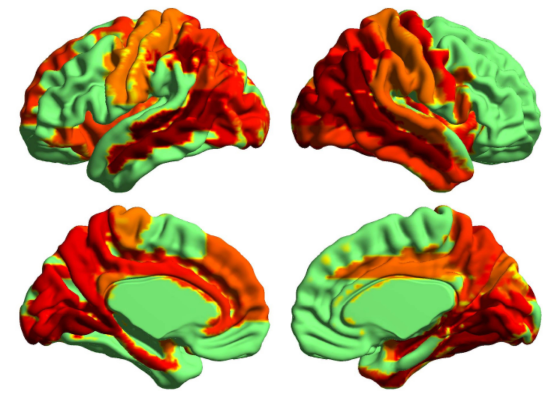
Bicycle Day Celebration Blotter. By YttriumOx CC BY-SA 3.0
On April 19 1943, seventy-four years ago to the day, Albert Hoffman conducted his now famous self-experimentation on the psychological effects of LSD, a compound he had been the first to synthesize some years earlier. Now called ‘bicycle day’ in honour of how Hoffman made his way home, it led to some remarkable descriptions:
“… Little by little I could begin to enjoy the unprecedented colors and plays of shapes that persisted behind my closed eyes. Kaleidoscopic, fantastic images surged in on me, alternating, variegated, opening and then closing themselves in circles and spirals, exploding in colored fountains, rearranging and hybridizing themselves in constant flux …”
In the decades that followed, academic research into LSD and other psychedelics was cast into the wilderness as worries about their recreational use held sway. Recently, however, the tide has started to turn. There is now gathering momentum for studies showing a remarkable clinical potential for psychedelics in treating recalcitrant psychiatric disorders, as well as experiments trying to understand how psychedelics exert their distinctive effects on conscious experience.
In a new paper published in Scientific Reports on this bicycle day anniversary, we describe a distinctive neuronal signature of the psychedelic state: a global increase in neuronal signal diversity. So – is this evidence for a ‘higher state’ of consciousness? And could it account for the nature of psychedelic experience? Let me answer these questions by summarizing what we did.
Our study analyzed data previously collected by Dr. Robin Carhart-Harris (Imperial College London) and Dr. Suresh Muthukumaraswamy (then Cardiff, now at Auckland). These were magnetoencephalographic (MEG) brain-imaging data from healthy volunteers either in a normal waking state, or after having taken LSD, psylocibin (the active ingredient in magic mushrooms) or ketamine (which in low doses acts as a psychedelic – in high doses it has an anaesethetic effect). MEG data combine a very high temporal resolution, with a much better spatial resolution than EEG (electroencephalography), allowing us to compute some relatively sophisticated mathematical measures of signal diversity. The participants in our study had passed strict ethical criteria, and were asked simply to rest quietly in the scanner during the experiment. Afterwards, they were asked various questions about what they had experienced.
With Carhart-Harris and Muthukumaraswamy, and with Dr. Adam Barrett and first-author Michael Schartner of the Sackler Centre for Consciousness Science here at Sussex, we chopped up the MEG data into small segments and for each segment calculated a range of different mathematical measures. The most interesting is called ‘Lempel Ziv (LZ) complexity,’ which measures the diversity of the data by figuring out how ‘compressible’ it is. A completely random data sequence would be maximally diverse since it is not compressible at all. A completely uniform data sequence would be minimally diverse since it is easy to compress. In fact, because of these properties the algorithm for computing LZ complexity is widely used to compress digital photos into smaller files, in an optimal way.

Changes in LZ complexity under LSD, as compared to the waking state. Data are source localized MEG. Image from Suresh Muthukumaraswamy and appears in Figure 3 in the paper.
We found that MEG signals had a reliably higher level of LZ – and hence signal diversity – for all three psychedelic compounds, with perhaps the strongest effects for LSD. The fact that we found the same pattern of results across all three psychedelic compounds is both striking and reassuring – it means our results are not likely to have arisen by chance.
Intuitively, these findings mean that the brain-on-psychedelics is less predictable, more random – and more diverse than in the normal waking state.
Our data can be thought of as evidence for a ‘higher’ state of consciousness only in this very specific way, and only in the context provided by other studies where a loss of consciousness has been associated with a reduction of neuronal diversity. For example, studies in our lab have shown reduced LZ complexity (reduced diversity) for both anaesthesia and for (non-dreaming) sleep. (Interestingly, levels of LZ returned to ‘normal’ during REM sleep when dreams are likely.) What’s striking about our results, in this context, is that increases in quantitative measures of conscious level, compared to the waking state, have never been found before.
Interpreting our data in terms of conscious level also make sense since measures of signal diversity, like LZ, can be thought of as approximations to related quantities like the ‘perturbation complexity index’ (PCI). This measure captures the diversity of the brain’s response to an electromagnetic stimulus: think banging on the brain (but using transcranial magnetic stimulation which applies a sharp electromagnetic ‘bang’), and listening to the echo. Studies using PCI, pioneered by Prof. Marcello Massimini at the University of Milan, have found a remarkable sensitivity to changes in conscious level, and even an ability to predict residual consciousness in devastating neurological conditions like coma and the vegetative state. The differences between LZ and PCI are subtle, having mainly to do with whether they measure simple diversity or a mixture of diversity and ‘integration’ in brain dynamics.
More generally, measures of diversity are related to influential theories which associate consciousness with ‘integrated information’ or ‘causal density’ in the dynamics of the brain. While these theories specify even more complicated mathematical measures of conscious level, the fact that we see measurable increases in diversity so reliably across conscious states gives some support to these theories. Our results are also consistent with Robin Carhart-Harris’ ‘entropic brain‘ theory, which proposes that the psychedelic state is associated with greater entropy or uncertainty in neural dyamics.
In this broader theoretical context, what’s interesting about our results is that they show that a measure of conscious level – previously applied to sleep and anesthesia – is also sensitive to differences in conscious content, as in the contrast between the psychedelic state and normal wakefulness. This helps shed some new light on an old debate in the science of consciousness – the relationship between conscious level (how conscious you are) and conscious content (what you’re conscious of, when you’re conscious).
Taking this research forward, we plan to understand more about how specific properties of neural dynamics relate to specific properties of psychedelic experiences. In the present study, we found some tentative correlations between changes in signal diversity and the degree to which people reported experiences like ‘ego dissolution’ and ‘vividness of imagination’. However, these correlations were not strong. One possible reason is that the subjective reports were taken outside the scanner, likely some time after the peak effect of the drug. Another possibility – which we are currently looking into – is that more fine-grained measures of information flow in the brain, like Granger causality, might be needed in order to closely map properties of psychedelic experience to changes in the brain.
Overall, our study adds to a growing body of work – much of which has been led by Carhart-Harris and colleagues – that is now revealing the brain-basis of the psychedelic state. Our data show that a simple measure of neuronal signal diversity places the psychedelic state ‘above’ the normal waking state, in comparison to the lower diversity found in sleep and anesthesia. Taking this work forward stands to do much more than enhance our understanding of psychedelics. It may help expose how, why – and for whom – psychedelics may help alleviate the appalling suffering of psychiatric disorders like depression. And in the end, it may help us figure out how our normal everyday conscious experiences of the world, and the self, come to be.
After all, everything we experience – even when stone cold sober – is just a kind of ‘controlled hallucination.’ Our perceptions are just the brain’s “best guess” of what’s going on, reined in by sensory signals. It’s just that most of the time we agree with each other about our hallucinations, and call them reality.
‘Increased spontaneous MEG signal diversity for psychoactive doses of ketamine, LSD and psilocybin’ by Michael Schartner, Robin Carhart-Harris, Adam Barrett, Anil Seth and Suresh Muthukumaraswamy is published in Scientific Reports (7): 46421, 2017. It is freely available here as an open-access publication. I am the corresponding author.
The study has been extensively covered in the media. Particularly good pieces are in The Guardian in the New Scientist and in Wired. There is also a highly active Reddit thread, which on the day of publication was consistently on the Reddit homepage.
I would like to specifically acknowledge Michael Schartner and Adam Barrett in this post. Michael’s Ph.D. – awarded just a few months ago – was all about measuring signal diversity in various different conscious states (sleep, anesthesia, psychedelia. Michael was primarily supervised by Dr. Barrett who devoted his considerable mathematical expertise to the project. Very many thanks are also due to Robin Carhart-Harris and Suresh Muthukumaraswamy for generously engaging with this collaboration.
Carhart-Harris, Muthukumaraswamy and colleagues have published a number of other important studies on the neural basis of the psychedelic state. See here and here – or just look on PubMed.

Have you guys tried or thought of a control group with stimulants, like ritalin, amphetamine, nicotine, MDMA (high entropy?) and control group with depressants like oxycodone, benzodiazepines and alcohol (low entropy?)
Plus, are you aware of this paper?
Driven by Compression Progress: A Simple Principle Explains Essential Aspects of Subjective Beauty, Novelty, Surprise, Interestingness, Attention, Curiosity, Creativity, Art, Science, Music, Jokes
https://arxiv.org/abs/0812.4360
There’s some synergistic energy between yours and Schmidhuber’s finding. However, I can’t put my finger on it yet.
Thanks! Yes we are very interested in specific manipulations of arousal and indeed you are right to point out links with Schmidhuber’s interesting work on artificial curiosity. ‘Compression progress’ is more a time-varying quantity than LZ complexity, but certainly they share many important features.
Pingback: What psychedelic research can, and cannot, tell us about consciousness | NeuroBanter